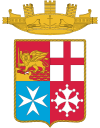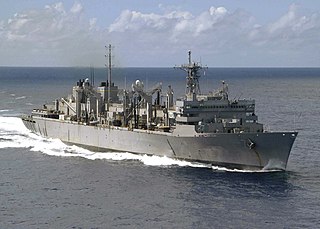
The fast combat support ship is a type of replenishment auxiliary ship. Different from traditional logistic ships, the fast combat support ship is designed with high speed to keep up with the carrier battle group/carrier strike group, while the multi-product station is capable of supplying all types of necessities for the fleet.

A hospital ship is a ship designated for primary function as a floating medical treatment facility or hospital. Most are operated by the military forces of various countries, as they are intended to be used in or near war zones. In the 19th century, redundant warships were used as moored hospitals for seamen.

Giuseppe Garibaldi is an Italian aircraft carrier, the first through-deck aviation ship ever built for the Italian Navy, and the first Italian ship built to operate fixed-wing aircraft. Although she is widely recognised as a carrier first and foremost, she is officially designated as an aircraft-carrying cruiser. She is equipped with short take-off and vertical landing (STOVL) aircraft and helicopters. Giuseppe Garibaldi was involved in combat air operations off Somalia, Kosovo, Afghanistan and Libya.
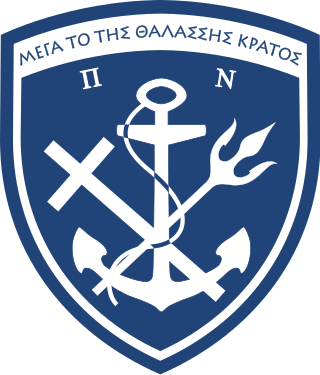
The Hellenic Navy is the naval force of Greece, part of the Hellenic Armed Forces. The modern Greek navy historically hails from the naval forces of various Aegean Islands, which fought in the Greek War of Independence. During the periods of monarchy it was known as the Royal Hellenic Navy.

Cavour is an Italian aircraft carrier launched in 2004. She is the flagship of the Italian Navy.

The Italian Navy is the navy of the Italian Republic. It is one of the four branches of Italian Armed Forces and was formed in 1946 from what remained of the Regia Marina after World War II. As of August 2014, the Italian Navy had a strength of 30,923 active personnel, with approximately 184 vessels in service, including minor auxiliary vessels. It is considered a multiregional and a blue-water navy.
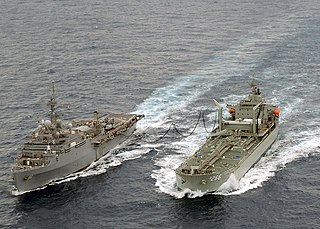
A replenishment oiler or replenishment tanker is a naval auxiliary ship with fuel tanks and dry cargo holds which can supply both fuel and dry stores during underway replenishment (UNREP) at sea. Many countries have used replenishment oilers.
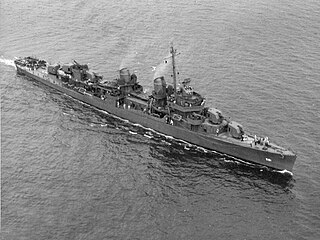
USS Charrette (DD-581) was a Fletcher-class destroyer of the United States Navy, named for Lieutenant George Charrette (1867–1938), who was awarded the Medal of Honor for heroism during the Spanish–American War. Entering service during World War II, she spent her career in the Pacific theatre. Placed in reserve following the war, Charette was transferred to the Kingdom of Greece in 1959 and renamed Velos (D16), remaining in service till 1991 before being preserved as a museum ship at Palaio Faliro, Athens.

HNLMS Jan van Brakel (F825) was a frigate of the Kortenaer class in service with the Royal Netherlands Navy from 1983 to 2001. She was renamed HS Kanaris (F464) on transfer to the Hellenic Navy in 2002.

The Zubr class, Soviet designation Project 1232.2, is a class of Soviet-designed air-cushioned landing craft (LCAC). The name "Zubr" is Russian for the European bison. This class of military hovercraft is, as of 2023 the world's largest hovercraft, with a standard full load displacement of 555 tons. The hovercraft was designed to sealift amphibious assault units from equipped/non-equipped vessels to non-equipped shores, as well as to transport and plant naval mines.

USS Waccamaw (AO-109) was a Cimarron-class replenishment oiler in the United States Navy. She was named after Waccamaw River. The original capacity was 146,000 barrels (23,200 m3).
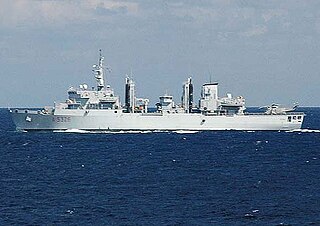
Etna is an auxiliary ship that entered service with the Marina Militare in 1998. She is designed to support fleet operations with fuel and dry stores. Etna is the single Italian vessel of the Etna class while a sister ship, HS Prometheus, was built under licence in Greece and entered service with the Hellenic Navy in 2003.

Patiño is a replenishment oiler of the Spanish Navy. It was named after the Spanish navy minister José Patiño Rosales, who reorganized the fleet on the orders of Philip V of Spain. The vessel was ordered in 1991 from Navantia and built at their yard in Ferrol, Galicia. The ship entered service with the Spanish Navy in June 1995 and is homeported at Ferrol. Patiño has been deployed with NATO forces around the world, participating in missions in the Kosovo War, the War in Afghanistan along with the European Union's anti-piracy mission to Somalia.
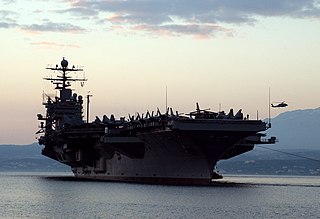
Crete Naval Base is a major naval base of the Hellenic Navy and NATO at Souda Bay in Crete, Greece.

The Vulcano class is a class of replenishment oiler used by the Italian Navy, with lead ship Vulcano of the class entered service on 12 March 2021. The ships are designed to support fleet operations with fuel and dry stores and expected to replace Stromboli class, another class of replenishment oiler from the Navy. Vulcano was financed under the 2014 Naval Law, for €346 million, then increased to €374.6 million, when the length was extended by 12 metres (39 ft). A second ship Atlante was ordered in January 2022 for projected delivery in 2025. The Navy also had an option for a third ship of the class. However, under the Italian MoD’s Multi-Year Defence Planning Document for the 2023-2025 timeframe, a fourth ship was added to the program.
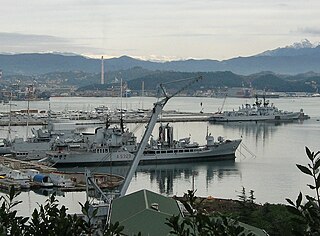
The Stromboli class is a series of two replenishment oilers used by the Marina Militare since 1975. They are to be replaced by the Vulcano class beginning in 2019.

The Akar class is a series of two replenishment oilers and fleet support ships, designed and built for service in the Turkish Navy. The lead ship of the class, TCG Akar, was constructed in 1982–1983 and entered service in 1987. The second ship, TCG Yarbay Kudret Güngör, was constructed in 1993–1994 and entered service in 1995. Both ships were constructed in Turkey, though Yarbay Kudret Güngör was the first ship built for the Turkish Navy by a private shipyard. Both vessels remain in service.

HNLMS Kortenaer (F807) was a frigate of the Kortenaer class. The ship was in service with the Royal Netherlands Navy from 1978 to 1997 and today serves as HS Kountouriotis with the Hellenic Navy. The frigate was initially named after Dutch naval hero Egbert Bartholomeusz Kortenaer and then after Pavlos Kountouriotis, distinguished Admiral of the Hellenic Navy, responsible for Greek naval victories in the Aegean Sea that secured the Aegean for Greece during the First Balkan War. The ship's radio call sign was "PADA".
The following is the structure of the Italian Navy as of June 2020. It is considered a multiregional and a blue-water navy.























